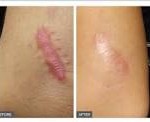Keloids
Keloids can be considered to be “scars that don’t know when to stop.” A keloid, sometimes referred to as a keloid scar, is a tough heaped-up scar that rises quite abruptly above the rest of the skin. It usually has a smooth top and a pink or purple color. Keloids are irregularly shaped and tend to enlarge progressively.
 Some keloids become quite large and unsightly. Aside from causing potential cosmetic problems, these exuberant scars tend to be itchy, tender, or even painful to the touch. Unlike scars, keloids do not subside over time. It is a result of an overgrowth of granulation tissue (collagen type 3) at the site of a healed skin injury which is then slowly replaced by collagen type 1. Keloids are firm, rubbery lesions or shiny, fibrousnodules, and can vary from pink to the colour of the patient’s flesh or red to dark brown in colour. A keloid scar is benign and not contagious, but sometimes accompanied by severe itchiness, pain,[2] and changes in texture. In severe cases, it can affect movement of skin.
Some keloids become quite large and unsightly. Aside from causing potential cosmetic problems, these exuberant scars tend to be itchy, tender, or even painful to the touch. Unlike scars, keloids do not subside over time. It is a result of an overgrowth of granulation tissue (collagen type 3) at the site of a healed skin injury which is then slowly replaced by collagen type 1. Keloids are firm, rubbery lesions or shiny, fibrousnodules, and can vary from pink to the colour of the patient’s flesh or red to dark brown in colour. A keloid scar is benign and not contagious, but sometimes accompanied by severe itchiness, pain,[2] and changes in texture. In severe cases, it can affect movement of skin.
Cortisone injections (intralesional steroids): These are safe and not very painful. Injections are usually given once every 4 to 8 weeks into the keloids) and usually help flatten keloids; The keloid may look better after treatment than it looked to start with, but even the best results leave a mark that looks and feels quite different from the surrounding skin.